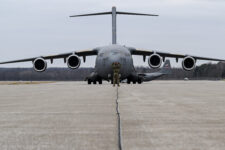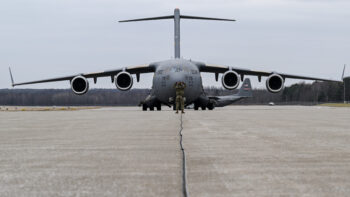
Navy carriers lined up at Norfolk, Va.
Mackenzie Eaglen knows Congress (after all, she did work there) and she takes readers through the most important policy debates sparked by the two versions of the 2021 National Defense Authorization Act. Read on! The Editor.
Much of the public debate about this year’s National Defense Authorization Act (NDAA) has focused on the renaming of U.S. military installations named for Confederates, banning the flying of the confederate flag, revision of the Insurrection Act, and preventing the use of defense dollars to build President Trump’s border wall.
Let’s dig deeper and peel back the onion on the bill’s policies about U.S. military strategy, readiness, and modernization. Here are five key issues to track:
Navy Procurement and Force Structure Assessment
It has been a difficult year for the Navy—on top of a troubled half-decade full of pay-to-play acquisition scandals, sex crimes, leadership firings and turnover, and several deadly ship collisions. Beside the coronavirus outbreaks on the U.S.S Teddy Roosevelt and the ensuing debacle surrounding the relief of Capt. Crozier and resignation of the acting Navy Secretary, the service has faced significant problems with its shipbuilding plans. Early this year, Defense Secretary Mark Esper criticized and withheld the Navy’s Force Structure Assessment. He directed Deputy Defense Secretary David Norquist to complete a review and compare the Navy’s proposal to plans from CAPE and the Hudson Institute. The release of the Navy’s Force Structure Assessment and 30-year shipbuilding plan is probably delayed until this fall.
 But Congress is tired of waiting for it. The House NDAA will withhold 75 percent of all operations and maintenance funds until the 30-year shipbuilding plan is delivered to Capitol Hill. It also prohibits retirement of any Navy vessel in 2021 until the force structure assessment is complete. The House bill also increases oversight on the Large Unmanned Surface Vessel, prohibiting its procurement until the Navy certifies that technologies in the ship’s key systems have adequately matured.
But Congress is tired of waiting for it. The House NDAA will withhold 75 percent of all operations and maintenance funds until the 30-year shipbuilding plan is delivered to Capitol Hill. It also prohibits retirement of any Navy vessel in 2021 until the force structure assessment is complete. The House bill also increases oversight on the Large Unmanned Surface Vessel, prohibiting its procurement until the Navy certifies that technologies in the ship’s key systems have adequately matured.
The Senate NDAA would require qualification of propulsion and electrical systems prior to initiating the medium and large unmanned surface vessel programs. These restrictions were followed by a scathing op-ed from SASC leaders James Inhofe and Jack Reed in which they criticized the Navy’s recent shipbuilding record and called for critical subsystems to be proven before the building of the lead ship of a new class. This “go slow to go fast” approach is being imposed upon the Navy by a fed-up Congress.
Congress has made it clear that it lacks confidence in the Navy’s planned force structure and its ability to build new vessels, particularly unmanned ships, without significant cost and schedule overruns. As the Navy begins planning its FY 2022 budget, it will have to deal with skepticism from Congress and the Office of Secretary of Defense and execute.
Big Budget Changes; Ending “Use It or Lose It”
Because operations and maintenance (O&M) funds are typically appropriated for one year at a time, any money left over at the end of the fiscal year is lost. This seemingly innocuous requirement leads to last-minute spending sprees lest offices and organizations signal to Congress they might not need as much money the following year. At almost $289 billion of $705 billion in total defense funding requested this year, the hurried expenditure of O&M dollars surely represents billions of dollars of inefficient spending over the years.
 HASC Ranking Member Rep. Mac Thornberry is trying to change this behavior before his retirement at the end of the year. He proposed an amendment to the House NDAA, which he’ll debate on the floor, to allow the Pentagon to spend 50 percent of unused O&M funds in the next fiscal year, which is allowed for many other federal agencies. HASC Chairman Adam Smith says he will support Thornberry. But the language is bound to cause controversy with appropriators who are reluctant to give up authority—especially when it could appreciably change defense spending habits.
HASC Ranking Member Rep. Mac Thornberry is trying to change this behavior before his retirement at the end of the year. He proposed an amendment to the House NDAA, which he’ll debate on the floor, to allow the Pentagon to spend 50 percent of unused O&M funds in the next fiscal year, which is allowed for many other federal agencies. HASC Chairman Adam Smith says he will support Thornberry. But the language is bound to cause controversy with appropriators who are reluctant to give up authority—especially when it could appreciably change defense spending habits.
But this is an authorizer vs. appropriator brawl well worth having. Indeed, the National Defense Strategy Commission recommended in its 2018 report for Congress “to authorize the Department to expend Operations and Maintenance funds from any given fiscal year across that fiscal year and the subsequent one.” It’s past time for this pot of money to have more flexibility—especially during a pandemic as the Pentagon’s needs change by the day.
The Senate policy bill also broadly targets bigger change to how the Pentagon plans, programs, budgets and executes its spending priorities. Language in the Senate NDAA sets up a process for the four defense committees to review proposed changes to the justification books by the Pentagon. Report language also directs the services to display all budget materials without including spending not controlled by that service. Congress is trying to address “pass through” spending that artificially inflates the Air Force’s topline and hurts its bottom line. There are additional directives to carry out a demonstration on data visualization of budget materials and encourage the Pentagon to use more “tagging” of the budget so that it can be better understood by outsiders.
Eliminating the Pentagon’s Chief Management Officer
After requiring studies of the Pentagon’s Chief Management Officer (CMO) position in last year’s NDAA, both the House and Senate have moved to eliminate the position in their bills. The May report from the Defense Business Board found the CMO position had been mostly ineffective due to lack of authority, unclear goals and turnover. These conclusions come only years after Congress upgraded the CMO position in an effort to bolster defense reform.
The Senate NDAA would eliminate the post no later than September 30, 2022, with the CMO’s authorities moving mostly to the Deputy Defense Secretary’s office. The Pentagon would be required to submit a list of all positions gaining the authorities of the former CMO. The House adopted similar language in an amendment proposed by Thornberry, who called the CMO position an “impossible job.” Although the House’s bill language contains a different timeline and reassignment of authorities, the post looks likely to disappear in the final NDAA.

Lisa Hershman
But Esper is likely to oppose elimination of the Chief Management Officer. That could prompt the White House to support keeping the CMO as well. Esper refers to the current CMO, as the “Secretary of the Fourth Estate”—the first portfolio of his “Night Court” process as secretary of defense.
Further, Hershman is the first CMO who actually meets the statutory requirements of the position and was only confirmed for the position six months ago. Esper will be able to argue that she needs more runway before her shop is closed. Additionally, the CMO team continues to perform and is building a unified POM for fiscal 2022 for all of the Fourth Estate, the first time it’s been done.
In the current defense-wide review process, the CMO was charged with identifying $5 billion in targeted savings. The CMO instead found $6.5 billion and an additional $3 billion in the services. She did so while also including the voice of the stakeholder in the proposed cuts for the first time. And no fuzzy math was allowed. Some offices in the department called out false savings as just delaying a contract, for example, and calling it “reform.” The CMO agreed. Now there are categories of outright cuts; wholesale change to operations or business processes; transfers of funds or duties elsewhere; and, delays to plans and programs. No longer are all “savings” also called defense “reform.”
Keeping U.S. Troops In Germany
All the defense committees in Congress this year are focused on the forward presence of U.S. forces around the globe. The defense bills are focused on unfunded priorities for EUCOM, AFRICOM, SOCOM and CENTCOM. More destroyers are set to be stationed in Rota, Spain. The Senate has established a new Pacific Deterrence Initiative (PDI) following the initiative proposed by Thornberry earlier this year.
After President Trump announced his intent to remove 9,500 American troops from Germany and cap the total number of military personnel in the country at 25,000, Congress has moved to stop this. The Pentagon, whose plans Trump approved in June, claims the move will not only meet the president’s guidance but will strengthen NATO and enhance Russian deterrence. Why? Probably because the troops are going to move elsewhere on the continent as opposed to come home entirely. (Latvia and Poland have both offered to host them.)
The House Armed Services Committee adopted an amendment by Reps. Gallego and Bacon which prohibits the withdrawal of troops until the Pentagon certifies the shift will not harm American or allied interests. Both Smith and Thornberry supported the amendment.
Similarly, Sen. Mitt Romney and a bipartisan group of co-sponsors have offered an amendment to the Senate NDAA to prevent the removal of troops until the Secretary of Defense certifies the withdrawal would not harm NATO or hinder current operations. These provisions set up a potential fight between the Trump administration and Congress regarding U.S. interests in Europe and America’s role in the NATO alliance.
The bicameral and bipartisan pushback on Trump’s plan is likely to prevail in the final bill—even if it risks a veto threat. That’s because members of Congress know that Germany has long been the keystone to an 8-decade coalition of the “strategic West.” Not only has it only grown over time “to include most of the rest of Europe and much of the western Pacific, it’s also been the nest for a remarkable growth in representative and liberal government.” Berlin’s government “is as robust a democracy as any, and the paradigm of a “responsible stakeholder” in the liberal international system,” according to Gary Schmitt and Giselle Donnelly of AEI.
Moreover, the White House’s arguments that rotational troops are (essentially) just as good at deterrence as forward-based permanent troops doesn’t stand up to recent history scrutiny. The Obama administration claimed similarly only to find Ukraine “now into its sixth year of a Russian invasion that has cost more than 14,000 Ukrainian lives and displaced millions.”
Pitting the F-35 Against the Virginia Class
Congress again is worried about an anemic shipbuilding request by the White House and the fact America does not have enough tactical aircraft for the Pentagon’s war plans. Both chambers want to support the building of more ships and more fighters. But the House and Senate bills currently are $2 billion apart on how much to spend on the F-35 and whether to procure a second Virginia-class attack submarine.
The Senate added $1.36 billion to buy 14 more Joint Strike Fighters. The House, on the other hand, wants to purchase the same number of F-35s as the Pentagon requested, and would cut funding for F-35 support infrastructure by $561 million. The difference is now left to be resolved in conference or by appropriators.
The Pentagon only requested funding for one Virginia-class submarine, presumably based on issues regarding executability, but both the House and Senate have moved to underwrite purchase of a second. The HASC provided full funding to buy the second submarine. The Senate, however, only included $472 million in advanced procurement for the second attack sub. This leaves many worried that shipyards in Connecticut and Virginia will have to lay off workers next year, potentially delaying work on the Navy’s other new boomer submarine—the Columbia. The shipbuilding industry has been hard hit by the pandemic and a strike continues at Bath Iron Works, further adding to the disruption.
Mackenzie Eaglen is a defense expert at the American Enterprise Institute and member of the Breaking D Board of Contributors.
Air Force mobility fleet seeks on-board defenses against small drones
Air Mobility Command documents say they’re interested counter-drone systems, including platforms that can operate near friendly aircraft, so as not to hypothetically accidentally jam or spoof a nearby vice president’s plane.


























